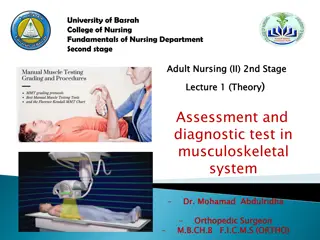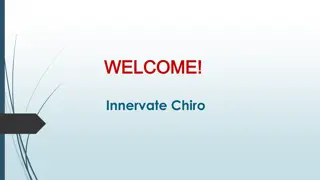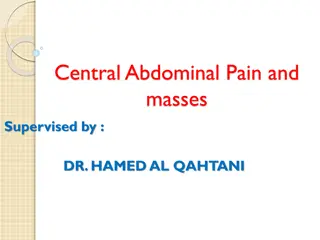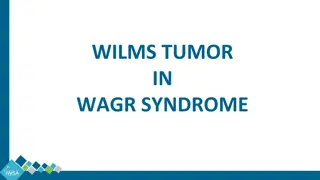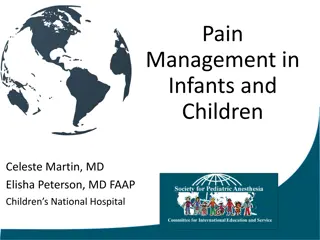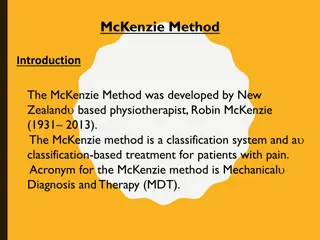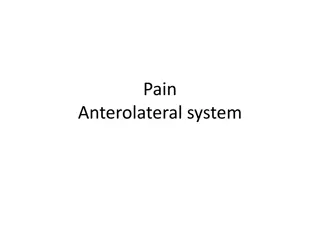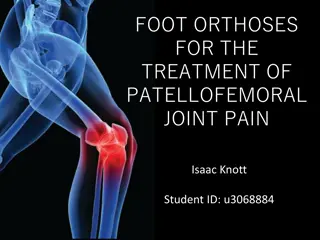Evaluation and Intervention for Patellofemoral Pain Syndrome
Clear guidance on PFPS etiologies, evaluation approaches, special tests, evidence-based interventions, and common complaints in outpatient settings. Learn about suggested theories, clinical presentation, diagnostic considerations, and exclusion criteria.
Download Presentation

Please find below an Image/Link to download the presentation.
The content on the website is provided AS IS for your information and personal use only. It may not be sold, licensed, or shared on other websites without obtaining consent from the author.If you encounter any issues during the download, it is possible that the publisher has removed the file from their server.
You are allowed to download the files provided on this website for personal or commercial use, subject to the condition that they are used lawfully. All files are the property of their respective owners.
The content on the website is provided AS IS for your information and personal use only. It may not be sold, licensed, or shared on other websites without obtaining consent from the author.
E N D
Presentation Transcript
University University of Family & Community Health Nursing Course Occupational Health Care Nursing Lecture 10 of Al Al- -Bayan / College of Nursing Bayan / College of Nursing Fourth Stage Fourth Stage - -Family & Community Health Nursing Course Occupational Health Care Nursing Lecture 10
Definition of Occupational Health Definition of Occupational Health Occupational health is an area of work in public health to promote and maintain highest degree of physical, mental and social well-being of workers in all occupations.
Definition of Occupational Definition of Occupational Health Nursing Health Nursing The promotion, prevention of and restoration of health within the safe and healthy thence high productivity. The specialty practice that focuses on the promotion, prevention of disease and restoration of health within the safe and healthy environment thence to achieve optimal health high productivity. specialty practice that focuses on the disease and injury and injury environment, , to achieve optimal health and and
Objectives of Occupational Health Nursing T To o adapt the nursing program to serve the health needs of the company with respect to its character, size and location. To treatment. To equipment and supplies. To exists. Objectives of Occupational Health Nursing adapt the nursing program to serve the health needs of the company with respect to its character, size and location. To give competent nursing care and treatment. To have and maintain adequate space, equipment and supplies. To obtain medical direction where none exists. give competent nursing care and have and maintain adequate space, obtain medical direction where none
Work Work Health Health Interaction Interaction
H Host ost Host to the Workplace Each worker represents a host within the working population group: Age and Gender Health Status Work Practice Ethnicity Lifestyle factors Host Factors Factors are Associated with Increased Risks
Cont.. Older workers have increased risk due to: Diminished sensory abilities. The effect of chronic illnesses. Delayed reaction times. Cont..
Cont. Women in child bearing years very susceptible to workplace exposure because: The hormonal changes during these years Trans-placental exposures
Agent Agent 1 1. Biological Agents: Are living organisms are capable of causing human diseases by infectious process. Bacteria, Viruses, Fungi Common in workplace (Health Care Facilities and Clinical Laboratories). . Biological Agents:
Cont.. 2. Chemical Various forms of chemicals- Medications Solutions Gases Vapors, aerosols 2. Chemical Agents Agents: :
Cont.. 3 3. Environmental and Are those that can potentially cause accidents, injury, strain or discomfort Unsafe/inadequate equipment Lifting devices and lifting heavy loads. Slippery floors Repetitive motions . Environmental and Mechanical Mechanical Agents: Agents:
Cont.. 4 4. Physical agent: Within the work environment include the following: Temperature extremes. Vibration (affects internal organs, supportive ligaments and the shoulder girdle structure). Noise Radiation Lighting Electricity . Physical agent:
Personal Personal Protective Equipment Includes Protective Equipment Includes Eye Protective Devices such as radiation Eye guards Protective clothing Devices for monitoring exposure to agents such as radiation guards clothing for monitoring exposure to agents
Cont.. 5 5. Psychosocial Interpersonal relationships among Employees and Coworkers and Managers are often sources of conflict and stress. . Psychosocial Agents Agents: :
Environment Environment Environmental Physical environment (Heat, Odor, Ventilation) influence the occurrence of host agent interactions. New environmental problems continue to arise such as: - An increase in industrial wastes and toxins. - Indoor and outdoor environmental pollution. Addictive behaviors (negative social environment) Environmental Factors: Factors:
Role of the Occupational health nurses are responsible for many functions that are significant to the prevention, investigation and treatment of workplace-related injuries and illnesses. There are OHNs Role of the Occupational Health Nurse Occupational Health Nurse There are some of the common some of the common Roles OHNs: Roles of of
Workplace Hazard OHNs are responsible for monitoring, evaluating and analyzing any recognized risks using the research they conduct on the effects of exposure to dangers in the workplace. OHNs collect and make use of hazard and health data to determine how best to put into place necessary control and preventive measures, which they intend to be an ongoing process. Workplace Hazard D Detection etection:
Case Management for Injuries: As a routine practice, OHNs act as case managers for non-work-related and work- related injuries and sicknesses. OHNs use case management in areas of short- and long-term disability benefits, group health, Family Medical Leave Act (FMLA) and workers' compensation for employees.
Preventative OHNs help keep employees productive and healthy by offering them preventative strategies like chronic disease monitoring, immunization, stress management, smoking cessation, nutrition and weight control and exercise and fitness. Risk Reduction Risk reduction and harm prevention are among some of the other areas of responsibility for occupational health nurses. They design programs for employees to encourage different positive changes to lifestyle and workplace practices. Preventative Health Health: Risk Reduction:
Counseling and Crisis Intervention: These nurses provide counseling and crisis intervention for other issues that may extend beyond the scope of counseling limited to care for only illnesses and injuries related to work. Many times, OHNs may counsel employees on issues involving substance use or their psychosocial needs and may work with a psychologist to deliver the best treatment possible.
Cont. Rehabilitation Therapy Another crucial responsibility of occupational health nurses is caring for employees that become ill or get hurt because of hazards in the workplace. OHNs may perform rehabilitation therapy following specific injuries and provide medication to patients. Rehabilitation Therapy:
Health Screening: OHNs also may be asked by an employer to screen prospective and new employees to make sure they're fit enough to complete the duties designated for their position. The pre- employment or onboarding screening can include drug and alcohol screening, physical examinations, hearing tests and vision tests.
Cont. Some of the other tasks completed by OHNs include Maintaining confidentiality of employees' personal health information and working with employers to comply with established codes of ethics and regulatory or legal requirements Implementing procedures and policies for continually assuring confidentiality Keeping documents required by the Occupational Safety and Health Administration (OSHA) Evaluating employees who have limitations or work restrictions and recommending appropriate job placement, Meeting eligibility requirements for being a medical employee who works with personal information Some of the other tasks completed by OHNs include : :




